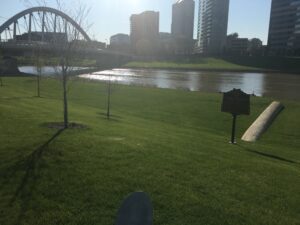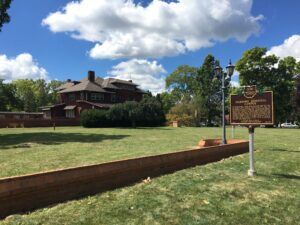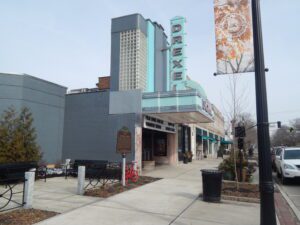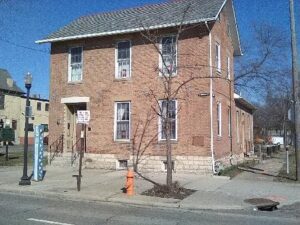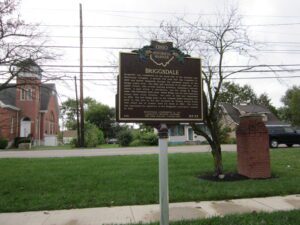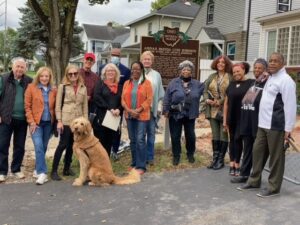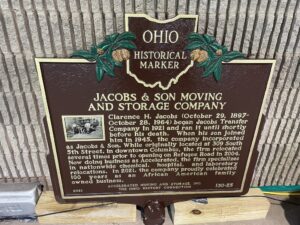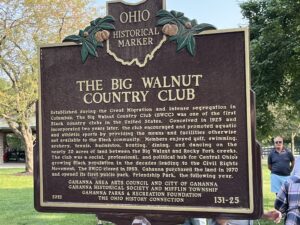, OH
The historic district extends from the former Main Street Bridge to Long Street and encompasses the public buildings on either side of the Scioto River. The 580 foot long low-head concrete arch Main Street Dam was constructed in 1918 in response to the catastrophic 1913 flood. The dam helped reshape the Downtown Columbus Scioto River basin into a reflecting pool for the monumental riverfront buildings of teh Civic Center, which were influenced by the City Beautiful movement of the 1890s and early 1900s. Nearly a century after its construction, however, the dam had contributed to an unhealthy environment for aquatic life and was removed in late 2013 as part of teh Scioto Greenways river restoration project.
, OH
The Harding Hospital, initially called the Columbus Rural Rest Home, was founded in 1916 by George T. Harding II, MD (1878-1934) and his associates, many of whom shared his commitment to service and his Seventh-day Adventist Christian faith. The psychiatic treatment center moved to Worthington in 1920. The hospital’s goal was to provide treatment with attention to the person’s physical, mental, social and spiritual needs. The program, with its emphasis on relational issues and psychotherapy, drew patients from across Ohio and beyond. In 1936 a residency program in psychiatry for physicians was started and educational programs for other mental health professionals followed. The campus’ beauty contributed to its being a place of healing for many. Since 1999, Harding Hospital has been a part of The Ohio State University’s Wexner Medical Center.
, OH
The Drexel Theatre is a significant example of the once-ubiquitous small neighborhood theatres that appeared in the 1930s, a time when movies were an inexpensive and popular form of entertainment. Designed by architect Robert R. Royce, the theatre was built in 1937 in a combination of Art Deco and Art Moderne styles. The P.F. Yoerger Sign Company designed the iconic marquee. The Drexel opened on Christmas Day 1937, showing the movie One Mile from Heaven, and has been in continuous operation ever since. In 2009, with the theatre falling on hard times, Friends of the Drexel and the Columbus Association for the Performing Arts came together to save and restore this artistic jewel for future generations to cherish. The Drexel Theatre was added to the National Register of Historic Places in 2015.
, OH
Thomas Jefferson was president when the original two-story Federal-style brick building was built in 1807. The house is located on the east half of in-lot 123, a part of Franklinton since its beginning. Surveyed by Nathanial Massie on October 28, 1796, the lot was part of Virginia Military District entry #1393, comprising 1,000 acres on the west fork of the Scioto River. Captain Robert Vance, a veteran of Virginia Continental Line during the Revolution, claimed the land. Lucas Sullivant, the founder of Franklinton, acquired it from Vance. The acreage was a part of the 1797 plat of Franklinton, recorded by Sullivant in 1802 at the Ross County Courthouse in Chillicothe. Franklinton became Franklin County’s first seat in 1803 and preceded the founding of Columbus by 15 years. In its early years, Franklinton’s nearest neighbors were the Wyndat and Haudenosaunee people. (Continued on other side)
, OH
Briggsdale was established on the north side of the Columbus and Harrisburg Turnpike, a private toll road that was completed in 1849 and passed diagonally through the southeast corner of the Briggs family farm. The 1893 plat consisted of 97 small lots, five public streets, and several existing buildings, including a railroad depot, a post office, a schoolhouse, and the Joseph M. Briggs home. The Italianate style home, where Briggs and his wife Louisiana raised their seven children, was built in 1881 and demolished in 1958. The last Briggs home on the original family farmstead was built on this site in 1911 and occupied by William Irving Briggs (the eldest son of Joseph) until his death in 1964. The house was demolished for expansion of the Briggsdale Apartments complex in 2018.
, OH
Aminah Brenda Lynn Robinson (1940-2015) and her son Sydney moved into this home in 1974. The artist, a visual historian, lived and worked here in the Shepard community until her passing. Raised in Columbus’s Poindexter Village and educated in the local public schools, Robinson also studied at Columbus College of Art and Design and The Ohio State University. Her art reflected stories handed down from her elders, experienced within her community, and the local history she researched while working at the Columbus Metropolitan Library. She received a 2004 MacArthur Award for her celebration of “family, ancestry, and the grandeur of simple objects in drawings, paintings, and large-scale, mixed-media assemblages.” (Continued on the other side)
, OH
Clarence H. Jacobs (October 29, 1897?October 28, 1964) began Jacobs Transfer Company in 1921 and ran it until shortly before his death. When his son joined him in 1945, the company incorporated as Jacobs & Son. While originally located at 309 South 5th Street, in downtown Columbus, the firm relocated several times prior to opening on Refugee Road in 2004. Now doing business as Accelerated, the firm specializes in nationwide chemical, hospital, and laboratory relocations. In 2021, the company proudly celebrated 100 years as an African American family owned business.
, OH
Established during the Great Migration and intense segregation in Columbus, The Big Walnut Country Club (BWCC) was one of the first Black country clubs in the United States. Conceived in 1925 and incorporated two years later, the club encouraged and promoted aquatic and athletic sports by providing the means and facilities otherwise not available to the Black community. Members enjoyed golf, swimming, archery, tennis, badminton, boating, dining, and dancing on the nearly 20 acres of land between the Big Walnut and Rocky Fork creeks. The club was a social, professional, and political hub for Central Ohio’s growing Black population in the decades leading to the Civil Rights Movement. The BWCC closed in 1963. Gahanna purchased the land in 1970 and opened its first public park, Friendship Park, the following year.


